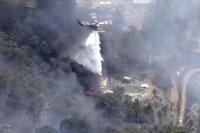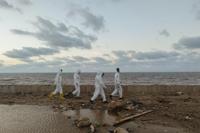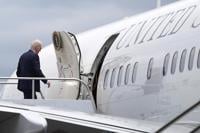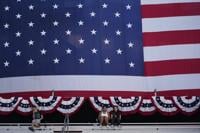At a rally for Nevada Republicans on Saturday, former President Donald Trump argued against the federal probe into the storage of classified documents at his Mar-a-Lago estate by falsely suggesting that past presidents did the same thing.
Trump that Barack Obama moved “truckloads” of documents to a former furniture store in Chicago, that Bill Clinton carted records “from the White House to a former car dealership in Arkansas,” and that George H.W. Bush “took millions of documents to a former bowling alley and a former Chinese restaurant where they combined them.”
In reality, ��ɫtv Archives and Records Administration staff, not the former presidents, transported presidential records to these facilities for temporary sorting and storage, following security protocols in the process, NARA statements and Associated Press reporting show.
That's very different from Trump from his own presidency in various storage areas at his Florida estate, said Timothy Naftali, a professor of public service and history at New York University.
“Obviously, it takes time to build a presidential library. During that period of time, the ��ɫtv Archives has to put these presidential records somewhere safe,” Naftali said. “They are not put in closets in public clubs.”
A spokesperson for Trump did not immediately respond to a request for comment.
Here's a closer look at the facts.
TRUMP: Bush "took millions of documents to a former bowling alley and a former Chinese restaurant where they combined them. So they’re in a bowling alley slash Chinese restaurant.”
THE FACTS: While the idea of the elder Bush sneaking documents to a combination bowling alley and Chinese restaurant inspired colorful , it's not accurate.
NARA archivists, not Bush, transported the documents to what had once been Chimney Hill Bowl in College Station, Texas, according to . They converted it into a warehouse, swapping bowling lanes for shelved storage where they could store the boxes of documents. To fit everything, they also co-opted a former Chinese restaurant next door.
Under the Presidential Records Act, NARA has custody of all presidential records from former administrations. The agency is responsible for sorting through the documents and storing them securely until a presidential library can be built to house them.
In the case of Bush's documents, the temporary storage facility NARA archivists used was protected by guards, television monitors and electronic detectors while documents were sorted, the AP reported at the time. They were later moved to the George H.W. Bush Presidential Library and Museum, also in College Station, where they reside today.
Trump's comments aimed to diminish the fact that he held classified documents in Mar-a-Lago by saying Bush held his own documents in an old bowling alley, Naftali said.
“But that’s complete nonsense,” he said. “These are buildings ��ɫtv Archives took over, renovated to meet archival standards and security, and then they put the materials there.”
Benjamin Hufbauer, a professor at the University of Louisville who researches presidential libraries, agreed Trump's claim was not correct. “It’s really an apples to oranges kind of thing,” he said.
___
TRUMP: Clinton "took millions of documents from the White House to a former car dealership in Arkansas."
THE FACTS: Clinton didn't take documents to an ex-car dealership, NARA did.
NARA in May 2000 that it would be transporting documents from Clinton's presidency to a Little Rock, Arkansas, storage facility that used to be the Balch Motor Company. The facility, which NARA rented, was less than 2 miles from what later became the William J. Clinton Presidential Library and Museum, where the documents are stored today.
___
TRUMP: Obama "moved more than 20 truckloads, over 33 million pages of documents, both classified and unclassified, to a poorly-built and totally unsafe former furniture store located in a rather bad neighborhood in Chicago with no security, by the way.”
THE FACTS: Again, — and followed its own storage standards in the process, the agency said.
Roughly 30 million unclassified Obama administration documents reside in a Chicago-area building that at one point belonged to the Plunkett furniture company, according to and government .
These documents are stored in accordance with the agency’s archival storage standards, according to NARA. Those include things like fire safety, pest management and security guidelines for certain types of documents.
to the city’s zoning commission prior to the end of Obama’s term also stipulated that the facility would be guarded overnight.
The administration’s classified documents are stored in separate secure locations in the Washington, D.C., area.
___
This is part of AP’s effort to address widely shared misinformation, including work with outside companies and organizations to add factual context to misleading content that is circulating online.






































